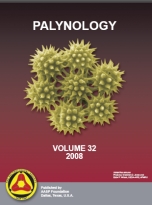Based on the lithology of the Izucar de Matamoros (IzM) sections, and the occurrence of index taxa such as Armeria, Cicatricosisporites dorogensis, Corsinipollenites, Eucommia, Momipites coryloides, Momipites tenuipolus, Mutisiapollis, and Ranuculacidites operculatus, a correlation between the IzM sections and the Cuayuca Formation stratotypes is proposed. The IzM sections are Late Eocene–Early Oligocene, and they are part of the evaporitic member (Mcy) of the Cuayuca Formation. These new data are consistent with the paleoenvironmental interpretations proposed for the formation. It was probably deposited under local xeric conditions in a semiarid climate that allowed the development of grassland (Gramineae with Amaranthaceae–Chenopodiaceae and Ephedra) and a thorn shrub community with Acacia, other Leguminosae, Linum, and Plumbaginaceae. The neighboring communities were probably tropical deciduous forests, low tropical deciduous forest, thorn forest, and chaparral. There were also regional temperate vegetations such as a Picea–Pinus forest, and a cloud forest community. Using parsimony analysis of endemicity, a biogeographic method, a palynofloristic relationship between the Cuayuca Formation and the Pie de Vaca Formation (Late Eocene–Early Oligocene) is proposed. Both formations are within the Balsas Group, and are correlated with San Gregorio Formation (Oligocene) of southern Baja California.
How to translate text using browser tools
1 December 2008
Correlation of the Late Eocene–Early Oligocene Izúcar de Matamoros Evaporites (Cuayuca Formation) in Mexico Based on Parsimony Analysis of Endemicity
Elia RamíRez-Arriaga,
Enrique Martínez-Hernández,
Hilda Flores-Olvera,
Helga Ochotorena,
Mercedes B. Prámparo
ACCESS THE FULL ARTICLE
It is not available for individual sale.
This article is only available to subscribers.
It is not available for individual sale.
It is not available for individual sale.

Palynology
Vol. 32 • No. 1
December 2008
Vol. 32 • No. 1
December 2008
biostratigraphy
Cuayuca Formation
Mexico
Paleogene Flora
parsimony analysis of endemicity
pollen
spores




